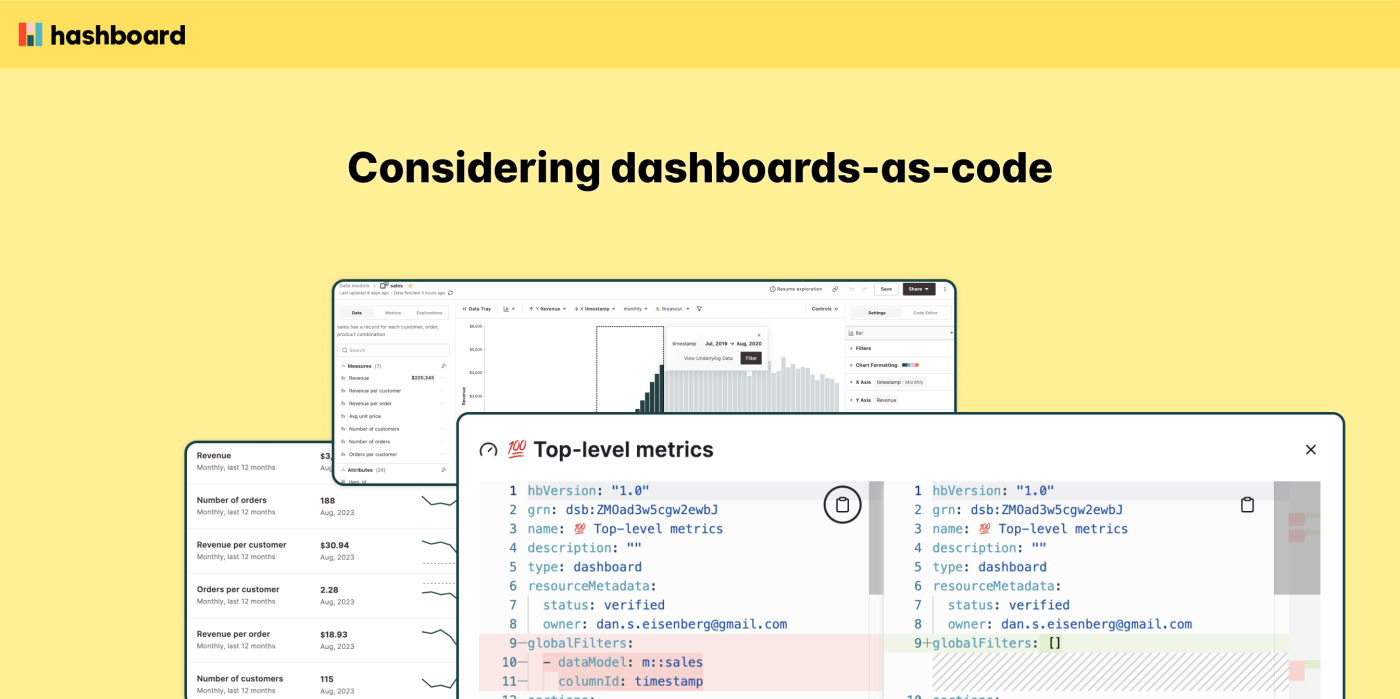
In today's data-driven landscape, Business Intelligence (BI) plays a critical role in helping organizations make informed decisions. Teams across marketing, product management, and beyond rely on BI to analyze key metrics like customer acquisition costs and feature activation. However, the ability to derive insights is often hampered by outdated or broken dashboards, leading to decisions based on approximations or best guesses.
While modern SaaS applications offer seamless, up-to-date experiences, BI tools have lagged behind. The diversity of stakeholders makes it challenging for data teams to replicate that seamless experience for everyone.
Enter BI-as-Code: an innovative approach that applies software development best practices to ensure data teams deliver reliable, always-current analytics. This approach transforms how organizations interact with their data, making insights more accessible and actionable than ever before.
What’s broken with BI today
Data-driven teams opt for semantic-based BI products because they provide a structured layer that simplifies raw data by organizing it into entities, such as tables, columns, measures, and relationships. However, these tools face several challenges:
Limited modularity: There’s no way for multiple developers to work on the same project concurrently without risking overwrites.
UI-Based restrictions: The grid-based layout of spreadsheet interfaces limits how data can be visually represented, especially for more advanced or unique data visualizations.
Poor adaptability: Most of these tools were built when infrastructure was static and monolithic, lacking the architecture to adapt to the demands of dynamic, modern data environments.
Addressing these issues isn't as simple as adding features to a roadmap. It requires a fundamental rethinking of BI architecture.
BI-as-Code with Hashboard
Hashboard is the first BI visualization tool to natively support code-based workflows for everything from the semantic layer down to dashboards. Data teams can integrate their entire BI stack into a continuous integration and continuous deployment (CI/CD) pipeline using our Command Line Interface (CLI). This addresses the change-management problems that result in outdated and broken dashboards.
Implementing BI-as-Code with Hashboard involves four key steps:
Git integration: Connect with an external Git repository (e.g., GitLab or GitHub) to create builds using hosted configuration files.
CI configuration: Determine which data stack changes to include in your CI process, based on end-user needs and regulatory requirements.
Preview capabilities: Visualize the entire state of your analytics before deployment.
Automated deployment: Configure pull requests to automate Hashboard builds using GitHub Actions or similar mechanisms.
This approach brings several benefits:
Improved reliability: Every CLI build triggers a validation check to verify the data warehouse is in sync with reporting tools to prevent broken dashboards.
Faster iteration: Adopt a CI/CD workflow for change management to test, validate, and deploy changes to meet stakeholder needs quickly.
Better governance: Improve data management between data engineers and non-coding analysts to enable self-service dashboard customizations.
Transform your analytics with Hashboard
BI-as-Code with Hashboard can be transformative, especially for larger, more mature organizations managing complex data stacks at scale. By bringing software development best practices to data engineering, Hashboard addresses the limitations of traditional BI tools.
However, for organizations with simpler data pipelines, Hashboard also supports UI-based, low-code dashboards, providing organizations with the flexibility to meet their current needs.
Eager to dive in and experience it for yourself? Get started for free today with Hashboard.
